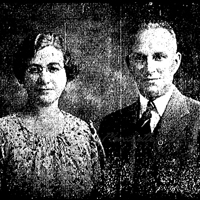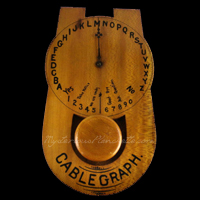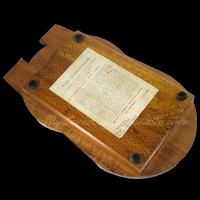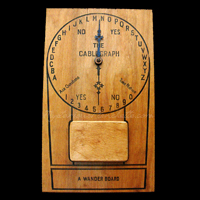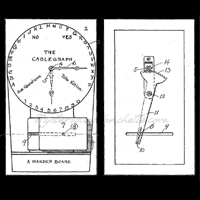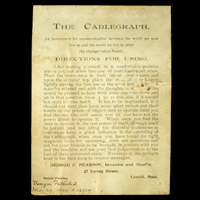Tracking down the elusive inventor and manufacturer of the Cablegraph has been a difficult task. The only research we've managed to turn up on George Foster Pearson indicates he was a native of Invergowrie, Scotland, who immigrated to the United States and settled in Ludlow, Massachusetts. This George Pearson was a prominent member of the community there, and apparently well liked. He was employed by Ludlow Manufacturing Associates, and both he and his wife were enthusiastic members of various fraternal organizations in the area, including the Order of the Eastern Star, Clan McLennan Scottish Clans, and the Brigham Masonic Lodge. He also served as town auditor until a local ordinance eliminated the position. Beyond these intriguing facts, and with fraternal involvement that invokes the early days of the Kennard Novelty Company, we know little else.
While all of that information sounds promising, both the 1900 and 1919 patents for Pearson's amazing talking boards indicate he was from Lowell, Massachusetts, some 90 miles northeast, and the rather reliable information we have from the Ludlow-based Pearson indicates he was a well-ingrained, life-long member of that community that had not relocated from elsewhere. Whether the two men are one and the same, or we have a case of mistaken identity, remains to be further researched, but it seems likely that the George Foster Pearson of Ludlow is the Cablegraph's creator.
While we can't positively ID Pearson, what we do know if that the Cablegraph's inventor had an interest in spirit communication. He seems to have been a believer, and managed to create some of the most beautifully-designed devices ever discovered. First patented in 1900, the "Cablegraph" is an awe-inspiring device. It was designed as, in the inventor's own words, "an instrument for the communication between the world we now live in and and the world we live in after the change called death." Manufactured from solid oak and measuring well over a foot long, the Cablegraph is related more closely to Dr. Hare's "Spiritoscopes" than to writing planchettes or ouija, and falls firmly into the "dial plate" category of talking boards. Of course, its great horseshoe shape reminds users to invoke their own magnetism to "charge" the board.
The Cablegraph operates by means of a pivoting handle that rests below the dial like the pendulum of a clock. Movement of the handle triggers an internal toothed gear that rotates the index of the dial, spelling out messages from the letters, numbers, and phrases there. It is a fairly complicated mechanism in the realm of talking board design, and a true innovation. It is unknown what kind of success Pearson had with his boards, or if their manufacture ever progressed beyond his own cottage industry, and the boards seem quite rare. He obviously had enough success to continue pursuit of the design, refining it in 1919 with a new patent and another run of the boards, this time with a more squared design that incorporated its predecessor's horseshoe shape into a reminiscent print on the face of the device.







